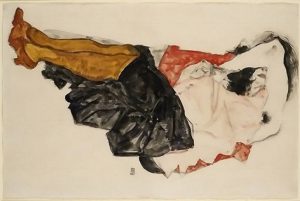von Herbert Gruber

Download this article as PDF
Bakalar vs Fischer und Vavra (german only)
Die Provenienz des verfahrensrelevanten Kunstwerks wurde wie folgt dargelegt:

1. Jane Kallir: Catalogue Raisonné 1998
Nr. 1974
Seated Woman with Bent Left Leg (Torso), Sitzende mit angezogenem linken Bein (Torso) Gouache and black crayon. Signed and dated, lower center, (35.1 x 25.5 cm) [sight].
Provenienz:
Provenance: Gutekunst & Klipstein, Bern; Galerie St.Etienne, New York; Norman Granz; Galerie St. Etienne, New York; David Bakalar
Exhibitions:
Bern, 1956, no. 51. ill.; New York, 1957, no. 28, ill.; Boston, 1960, no. 63, ill.
Literature:
Kenyon Review, 1964, facing p. 616
2. Gutekunst und Klipstein
Lager- und Ausstellungskatalog Nr. 57,
Ausstellung Egon Schiele
8. September bis 6. Oktober 1956
Nr. 51
Sitzende mit angezogenem linkem Bein. Schwarze Kreide u. Tempera. 35,1:25,2 cm. Sehr schöne farbige Zeichnung, Auf glattem Maschinenpapier. Voll signiert und « I917» datiert.
3. Sotheby´s in London
Am 8.2.2005 wurde bei Sotheby´s in London das Kunstwerk um GBP 400.000,00 versteigert. Die Provenienz wurde wie folgt dargelegt:
Fritz Grünbaum, Vienna (until 1941)
Elisabeth Grünbaum-Herzl, Vienna (widow of the above; until 1942; thence by descent)
Mathilde Lukcas – Herzl (sister of the above)
Gutekunst & Klipstein, Bern (on consignment from the above by 1956)
Galerie St. Etienne, New York
Norman Granz, New York[1]
Galerie St. Etienne, New York
Acquired from the above by the present owner
Am 10.2.2005 kontaktierte der Anwalt der Erben nach Fritz Grünbaum, Dr. Gabriel Lansky Sotheby´s London und bezog sich auf eine Information der IKG Wien – Frau Erika Jakubovits – wonach das gegenständliche Werk der Sammlung von Fritz Grünbaum entstammt. Er forderte Sotheby´s auf das Kunstwerk einzufrieren bis zur Klärung der Eigentumsverhältnisse.
Der Käufer des Bildes wurde von Sotheby´s über diese Forderung informiert daraufhin trat er vom Kauf zurück.
 Es gab Gespräche mit Repräsentanten von Sotheby´s und es waren weitere Termine vereinbart, als am 21.3.2005 der Besitzer des nunmehr nicht verkauften Bildes, Herr David Bakalar[2], Klage gegen die beiden Erben von Fritz Grünbaum am United States District Court Southern District of New York zur Zahl 05 Civ. 3037 (WHP) einbrachte.
Es gab Gespräche mit Repräsentanten von Sotheby´s und es waren weitere Termine vereinbart, als am 21.3.2005 der Besitzer des nunmehr nicht verkauften Bildes, Herr David Bakalar[2], Klage gegen die beiden Erben von Fritz Grünbaum am United States District Court Southern District of New York zur Zahl 05 Civ. 3037 (WHP) einbrachte.
Die Klage lautete auf Feststellung seiner Eigentümerschaft und Schadenersatz in der Höhe von USD 650.000,–.
Da einer der Erben in New York wohnt, war die Klageerhebung in New York möglich.
Nachdem die Anwälte 7500 Dokumente ausgetauscht hatten, stellte das Gericht am 18.September 2008 die Eigentumsrechte von Herrn David Bakalar am gegenständlichen Bild fest.Die Klage auf Schadenersatz war von Bakalars Anwälten zurückgezogen worden.
Der Einzelrichter Hon. William H. Pauley III erachtete Schweizer Recht für seine Entscheidung maßgeblich, obwohldas Bild dem in Österreich lebenden und in  Deutschland ermordeten Fritz Grünbaum gehörte. Es war in Wien 1938 letztmalig nachweisbar, bevor es 1956 in der Schweiz an Otto Kallir veräußert wurde.
Deutschland ermordeten Fritz Grünbaum gehörte. Es war in Wien 1938 letztmalig nachweisbar, bevor es 1956 in der Schweiz an Otto Kallir veräußert wurde.
Der Einzelrichter Hon. William H. Pauley III erachtete Schweizer Recht für seine Entscheidung maßgeblich, obwohl
- das Bild dem in Österreich lebenden und in Deutschland ermordeten Fritz Grünbaum gehörte. Es war in Wien 1938 letztmalig nachweisbar, bevor es 1956 in der Schweiz an Otto Kallir veräußert wurde.
- das Bild nach 1956 an in den USA durch Otto Kallir zweifach gehandelt und an Herrn David Bakalar verkauft wurde.
- Laut Aussage des Schweizer Galeristen Eberhard W. Kornfeld (Gutekunst & Klipstein) kauft er das Bild am 24.4.1956 von Mathilde Lukacs (damals Brüssel) und verkaufte es am 18. September 1956 an Otto Kallir. Somit befand sich das Bild knapp 5 Monate in der Schweiz.
Wesentlicher Grund zur Rüge der erstgerichtlichen Entscheidung war der Konflikt der Rechtssysteme von
- Österreich
- New York und der
- Schweiz
sowie die Entscheidung des Gerichtes, ausschließlich Schweizer Recht zu Anwendung zu bringen.
Begründet wurde diese Entscheidung mit dem Umstand, dass der Verkauf des Bildes an den Otto Kallir in der Schweiz stattfand.
Korrekt wäre aber die Berücksichtigung
- des Österreichischen Rechts für die erbrechtliche Situation nach Fritz Grünbaum
- des Schweizer Rechts für den Ankauf des Bildes
- des Rechts des Staates New York[3] für den Ankauf des Bildes durch Otto Kallir und dessen zweimalige Weiterveräußerung an Norman Granz und an David Bakalar.
Zum Stand des zweitinstanzlichen Verfahrens:
 Stewart E. Eizenstat[4] und die IKG Wien traten dem zweitinstanzlichen Verfahren als Amicus Curiae[5] auf Seiten der Erben des Fritz Grünbaum bei.
Stewart E. Eizenstat[4] und die IKG Wien traten dem zweitinstanzlichen Verfahren als Amicus Curiae[5] auf Seiten der Erben des Fritz Grünbaum bei.
Am 11.03.2009 korrigierte das Appelationsgericht eine Entscheidung der Erstinstanz, wonach eine Rechtsmeinung der Wiener Anwältin der Grünbaum Erben, Dr. Kathrin Höfer, doch verfahrensrelevant zuzulassen ist.
Am 9.10.2009 fand eine mündliche Tagsatzung statt, in welcher vor allem der Konflikt der verschiedenen Gesetze und deren Konsequenzen diskutiert wurden. Stimmung und Inhalt der Tagsatzung lassen sich aus nachfolgender Äußerung eines der drei Richter ersehen:
JUSTICE KORMAN:
…….Perhaps that would be so if, in fact, there was a claim against a Swiss citizen. In other words, I’m not going to be prepared to quarrel if, if, if there was a claim against Kornfeld and the action, you know, damages of replevin was brought against him, but right now, no Swiss citizen, no Swiss business is at all implicated and what you have is, under my premise, stolen property being introduced into New York.
Aktuell kann keine Aussage darüber getroffen werden, wann eine Entscheidung ergehen wird. Die zweite Instanz hat zur zeitlichen Abfolge ihrer Tätigkeit keinerlei Vorgaben.
Zusammenfassung:
Ein Verfahren wie dieses kann nur im Bundesstaat New York geführt werden, der Verfahrensstand resultiert aus einer gescheiterten bzw. zurückgezogenen Klage auf Schadenersatz und der weiterhin aufrechten Gegenklagen der Erben, entsprechend dem Grundsatz in der US Verfahrensführung „Wer nicht klagt hat schon verloren“.
Das Appellationsgericht hat die Möglichkeit das Verfahren an die Erstinstanz zurück zu verweisen, dies meist mit verfahrensprägenden Verbesserungsaufträgen, oder es kann selbst eine Entscheidung fällen.
[1] Norman Granz (* 6. August 1918 in Los Angeles; † 22. November 2001 in Genf) war ein US-amerikanischer Jazz-Impresario und -produzent.
[2] David Bakalar, Geboren 1931, Industrieller, Künstler und Kunstsammler, früherer Eigentümer der Firma Transition, der ehemaligen Nummer 2 am Weltmarkt der Transistorenhersteller, dies nach Texas Instruments, Transition hatte zur Hochblüte 10.000 Mitarbeiter. Im Jahre 1980 wurde Transition verkauft. Mit 62 startete David Bakalar eine Karriere als Bildhauer, mit 75 produzierte er seinen ersten Film.
[3] Das Recht des Staates New York kennt eine Besonderheit, nämlich dass ein Dieb in der Kette der Besitzer die Kette aller Besitzer bricht und ein gutgläubiger Erwerb nicht mehr erlangt werden kann.
Jedenfalls Mathilde Lukacs hat das Eigentum am Bild niemals rechtmäßig erworben.
[4] US Chefverhandler während der Administration Clinton in Washington, welche als eines der Resultate das Allgemeine Entschädigungsfondsgesetz hatten
[5] Der Amicus ist v.a. jemand, der wesentliche fachliche Aspekte des Rechtsstreits und möglicher Entscheidungen hervorhebt. Er kann vertiefte Informationen und Sachkenntnis dem entscheidenden Gericht zur Verfügung stellen. Indes braucht er nicht völlig unabhängig zu sein, maßgeblich ist, nicht Partei zu sein. Amicus ist sogar häufig jemand, dessen Interessen indirekt durch den Rechtsstreit und die Entscheidung betroffen sein könnten. Es ist auch statthaft, eine Interessenseite oder einen Teilaspekt zuzuspitzen und pointiert vorzutragen. Gerade im Widerstreit und in der Gewichtung der Argumente erweist er dem Gericht einen „Freundschaftsdienst“. Im angelsächsischen Rechtssystem tritt der Amicus Curiae als eine Art parteiischer Sachverständiger auf, wie z. B. in den USA die Bürgerrechtsorganisation ACLU.


 Egon Schiele, Self Portrait 1914
Egon Schiele, Self Portrait 1914





